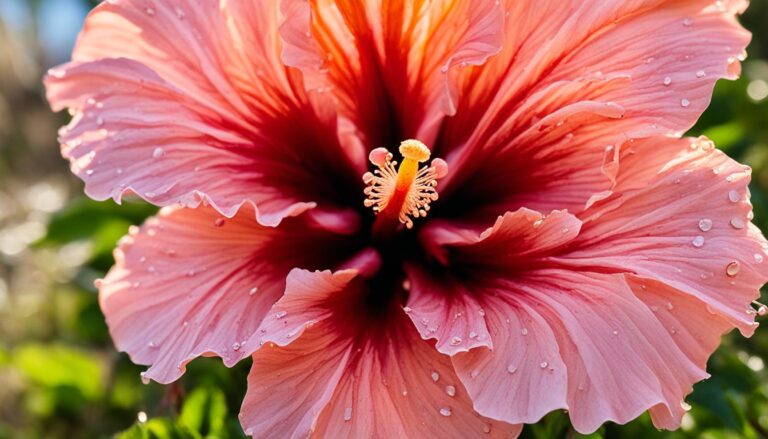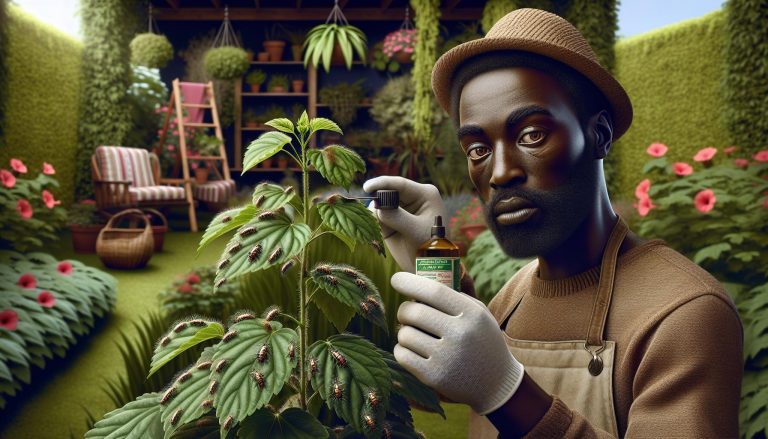Watering Hibiscus in Florida: How Often Is Best?
Meet Emily, a passionate gardener from Florida. She has always been fascinated by the vibrant colors and delicate blooms of hibiscus flowers. Last spring, Emily decided to add some hibiscus plants to her backyard garden, hoping to create a tropical oasis in her own backyard.
Excitedly, Emily brought home a variety of hibiscus plants in different sizes and colors. As she carefully planted them in well-drained soil under the warm Florida sun, she couldn’t help but wonder how often she should water her new botanical beauties. She wanted to make sure she gave them just the right amount of water for them to thrive.
Like Emily, many hibiscus enthusiasts in Florida often find themselves wondering about the ideal watering frequency for their beloved plants. After all, striking the perfect balance is essential for ensuring their hibiscus plants stay healthy and vibrant all year round, despite the hot and humid Florida climate.
Head on to the next section to discover the best watering practices for hibiscus plants in Florida and learn how to keep these tropical beauties flourishing in your own garden.
Key Takeaways:
- Understanding the watering needs of hibiscus plants is essential for their successful growth in Florida.
- Hibiscus plants should be watered thoroughly every couple of days for the first few weeks after planting, and then the watering frequency can be adjusted as they establish.
- Regularly check the soil moisture by sticking a finger a few inches below the surface to ensure it’s moist but not waterlogged.
- Establish a watering schedule based on the age and growth stage of the hibiscus plant, adjusting it as needed depending on weather conditions.
- Proper watering techniques, such as saturating the soil around the roots, will help maintain healthy and vibrant hibiscus plants.
Ideal Soil Conditions for Hibiscus in Florida
Hibiscus plants in Florida thrive when grown in well-drained soil with specific pH requirements. To ensure optimal growth and flowering, it’s important to understand the hibiscus soil requirements and maintain the appropriate pH level.
Hibiscus plants in Florida prefer well-drained soil with a pH range between 5.8 and 6.5. This pH range provides the ideal conditions for the plants to absorb nutrients efficiently and maintain overall health.
When planting hibiscus in Florida, you can use a generic potting mix specifically formulated for hibiscus flowers. To enhance the soil’s pH balance, consider adding compost at the time of planting. This will provide essential organic matter and help maintain the desired pH range.
| Soil Requirement | Potting Mix | Compost |
|---|---|---|
| Well-Drained Soil | Yes | Yes |
| pH Range: 5.8-6.5 | Yes | Yes |
In addition to providing the right soil conditions, regular fertilization is crucial for hibiscus plants in Florida. During the growing season, fertilize the plants every two weeks using a liquid fertilizer. Alternatively, you can opt for a slow-release fertilizer every eight weeks. This regular fertilization will supply the necessary nutrients for robust growth and vibrant blooms.
By understanding and meeting the hibiscus soil requirements, you can ensure that your plants have the ideal conditions for thriving in the Florida climate.
Best Planting Practices for Hibiscus in Florida
When it comes to planting hibiscus in Florida, following best practices will ensure that your plants thrive and add a vibrant touch to your garden. The ideal planting time for hibiscus in Florida is during the spring, summer, and fall months. These warm seasons provide the optimal conditions for hibiscus to establish strong roots and experience robust growth.
When selecting hibiscus plants for planting, it’s recommended to purchase young plants from a trusted local nursery or start from seedlings. This ensures that you are getting healthy plants that are well-suited for the local climate and soil conditions.
When planting hibiscus in Florida, it’s essential to choose a location that receives full sunlight throughout the day. Hibiscus plants thrive in bright, sunny areas and require at least six hours of direct sunlight to bloom beautifully.
To plant your hibiscus, dig a hole that is deep enough to accommodate the entire root ball. The top of the root ball should be level with the surface of the soil. This allows the roots to spread and establish themselves properly.
Additionally, hibiscus plants grow better in the ground than in containers, as it allows them to develop a stronger root system. Plant them along or at the end of flower beds to create a stunning visual impact and ensure they stand out in your garden.
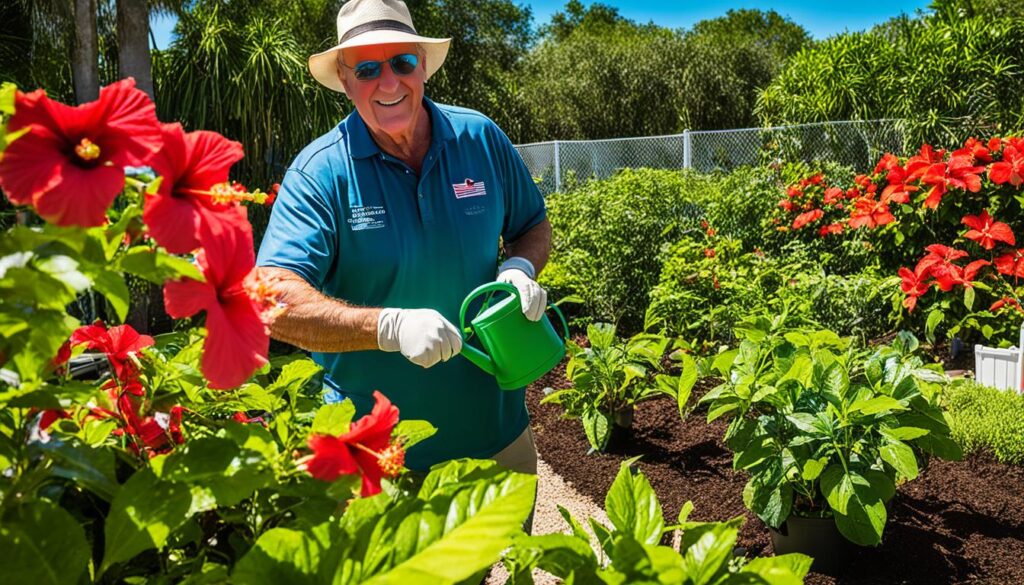
Once planted, it’s important to water hibiscus deeply during the early stages to keep the soil moist. This helps the plants establish themselves and encourages healthy growth. Watering hibiscus deeply allows the roots to absorb moisture from a deeper level, ensuring they are adequately hydrated.
Hibiscus Planting Practices in Florida
| Planting Time | Location | Young Plants | Watering |
|---|---|---|---|
| Spring, Summer, and Fall | Full Sunlight | Purchase from a local nursery or start from seedlings | Water deeply during early stages |
Following these planting practices will give your hibiscus plants the best start and set them up for success in your Florida garden. Remember to provide them with regular care, including proper watering, fertilizing, and pruning, to ensure they continue to thrive and showcase their stunning blooms.
Watering Tips for Newly Planted Hibiscus in Florida
Properly watering newly planted hibiscus in Florida is crucial for their successful establishment. Here are some tips to help you ensure their health and vitality:
- Thoroughly water every couple of days: For the first few weeks after planting, it’s important to water newly planted hibiscus thoroughly every couple of days. This consistent watering will help establish their root systems and prevent transplant shock. Be sure to soak the soil around the plants to ensure proper hydration.
- Keep the soil moist: The hot Florida heat can be challenging for freshly planted hibiscus, so it’s important to keep the soil around them moist. Monitor the soil moisture by gently sticking your finger a few inches below the surface. If the soil feels dry, it’s time to water again.
- Apply mulch: To help retain moisture and protect the newly planted hibiscus, apply a layer of mulch over the planting area. Mulch helps regulate soil temperature, reduce weed growth, and retain moisture. Spread a 2-3 inch layer of organic mulch around the base of the plants, keeping it a few inches away from the stem to prevent rot.
Remember, the goal is to keep the soil moist but not waterlogged. Providing consistent and adequate moisture during this critical period will promote healthy root development and ensure the long-term success of your newly planted hibiscus.
Watering Schedule for Established Hibiscus in Florida
Once your hibiscus plants have become established in the sunny Florida climate, maintaining a proper watering schedule is essential for their continued health and vitality. By following a regular watering routine, you can ensure that your mature hibiscus plants thrive and produce vibrant blooms.
During the first year after planting, it is recommended to water your established hibiscus plants twice a week. This frequent watering helps them establish their root systems and adapt to their new environment. However, as they mature and become more resilient, you can gradually reduce the watering frequency.
In the second year and beyond, a weekly watering schedule is generally sufficient for mature hibiscus plants in Florida. This allows the plants to receive an adequate amount of moisture while also preventing overwatering, which can lead to wilted appearance, discolored leaves, and unpleasant-smelling roots.
Regularly check the moisture level of the soil by sticking your finger a few inches below the surface. If it feels dry, it may be time to water your hibiscus. However, be cautious not to water them excessively, as they prefer moist soil rather than soggy conditions.
Watering Tips for Established Hibiscus in Florida:
- Water mature hibiscus plants twice a week during their first year.
- Reduce the watering frequency to once a week starting from the second year onwards.
- Monitor the soil moisture regularly by checking a few inches below the surface.
- Avoid overwatering, as hibiscus plants can show signs of distress due to excessive moisture.
| Plant Age | Watering Frequency |
|---|---|
| First Year | Twice a week |
| Second Year and Beyond | Once a week |
A consistent and suitable watering schedule is essential for maintaining the health and longevity of your established hibiscus plants in Florida. By paying attention to their moisture needs and adjusting your watering routine accordingly, you can enjoy the beauty of these stunning flowers for years to come.
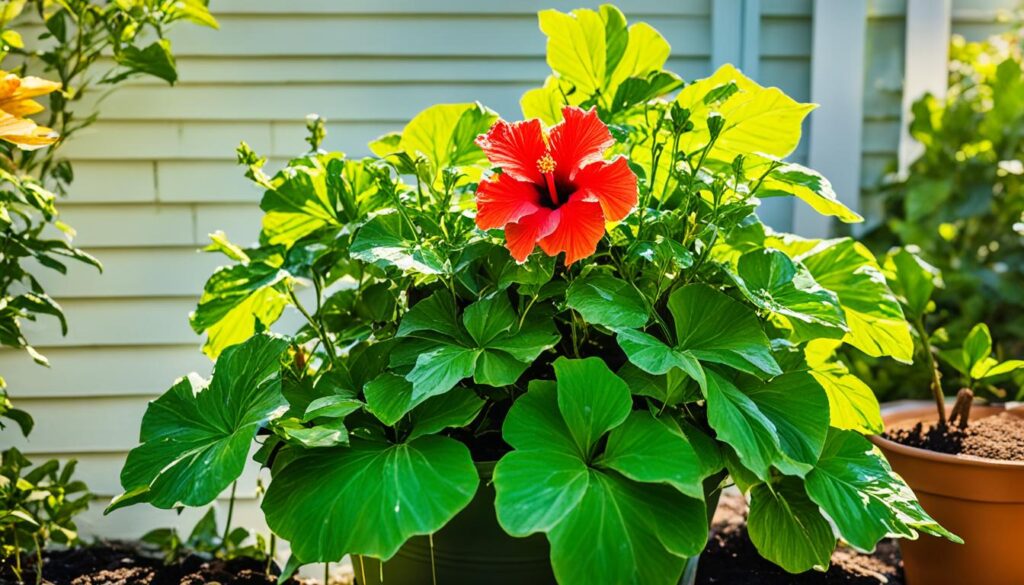
Watering Tips for Container-Grown Hibiscus in Florida
Growing hibiscus in containers in Florida requires a slightly different approach. To ensure their growth and health, follow these essential watering tips.
Container Selection
When choosing a container for your hibiscus plant, opt for a smaller size to promote slightly rootbound growth. This encourages the plant to focus on flower production rather than excessive foliage. Ensure the container has proper drainage to prevent waterlogging.
Regular Watering
Container-grown hibiscus in Florida need regular watering to maintain optimal moisture levels. Check the potting mix regularly, and water when the top inch of the soil feels slightly dry. Avoid overwatering, as it can lead to root rot. Remember, container-grown hibiscus may require more frequent watering due to the limited amount of soil.
Self-Watering Pots and Drip Irrigation
To maintain a consistent level of moisture in container-grown hibiscus, consider using self-watering pots or setting up a drip irrigation system. Self-watering pots have a reservoir that slowly releases water as the plant needs it, while drip irrigation systems provide a controlled and efficient way to deliver water directly to the plants’ roots.
Fertilization
Just like hibiscus plants in the ground, container-grown hibiscus in Florida benefit from regular fertilization. Use a high potassium fertilizer specifically formulated for hibiscus plants. Follow the manufacturer’s instructions for application rates and frequency to ensure healthy growth and abundant blooms.
| Watering Tips for Container-Grown Hibiscus | Summary |
|---|---|
| Choose a smaller container with good drainage. | Promotes slightly rootbound growth for better flower production. |
| Water regularly, checking the top inch of soil for dryness. | Avoid overwatering and maintain optimal moisture levels. |
| Consider using self-watering pots or drip irrigation systems. | Maintain consistent moisture levels for healthy growth. |
| Fertilize regularly with a high potassium fertilizer. | Provides essential nutrients for vibrant blooms. |
Watering Indoor Hibiscus in Florida
Hibiscus plants can bring a touch of the tropics into your home in Florida. Whether you don’t have a garden or simply want to enjoy their vibrant foliage year-round, indoor hibiscus plants can be a beautiful addition to your living space. To ensure their health and growth, it’s important to understand the proper care, including watering, for these indoor beauties.
First, find a bright spot in your home with plenty of sunlight, as hibiscus plants thrive in full sunlight. Place your indoor hibiscus near a south-facing window or group it with other sun-loving plants to create a sunny spot. Humidity is crucial for hibiscus, so consider placing a tray of water near the plant or using a humidifier to maintain optimal humidity levels.
When it comes to watering your indoor hibiscus, it’s essential to strike the right balance. Overwatering can lead to root rot, while underwatering can cause wilting and stress. To determine when to water, check the top inch of soil. If it feels dry to the touch, it’s time to water. However, if it still feels moist, wait a bit longer before watering. Avoid letting the soil dry out completely, as this can be detrimental to the plant.
During the flowering period, indoor hibiscus plants may require more frequent watering. As the plant stops flowering, reduce the watering schedule. Pay attention to the growth of the plant and adjust the watering frequency accordingly. Gradually increase the watering as you observe new growth and increased activity.
When watering your indoor hibiscus, it’s best to use room temperature water to prevent shock to the plant. Allow the water to run through the potting mix until it drains out from the bottom, ensuring that the roots receive adequate moisture. Discard any excess water that accumulates in the saucer, as hibiscus plants don’t like to sit in standing water.
Remember that every indoor environment is unique, and factors such as temperature, humidity, and the size of the pot can influence how often your indoor hibiscus needs watering. Therefore, it’s important to monitor the moisture levels in the soil and adjust your watering schedule accordingly.
Tips for Caring for Indoor Hibiscus Plants in Florida:
- Place your hibiscus in a bright spot with plenty of sunlight.
- Maintain optimal humidity levels by using a humidifier or placing a tray of water nearby.
- Water your indoor hibiscus when the top inch of soil feels dry.
- Avoid overwatering or letting the soil dry out completely.
- Use room temperature water and ensure proper drainage.
- Monitor the plant’s growth and adjust the watering schedule accordingly.
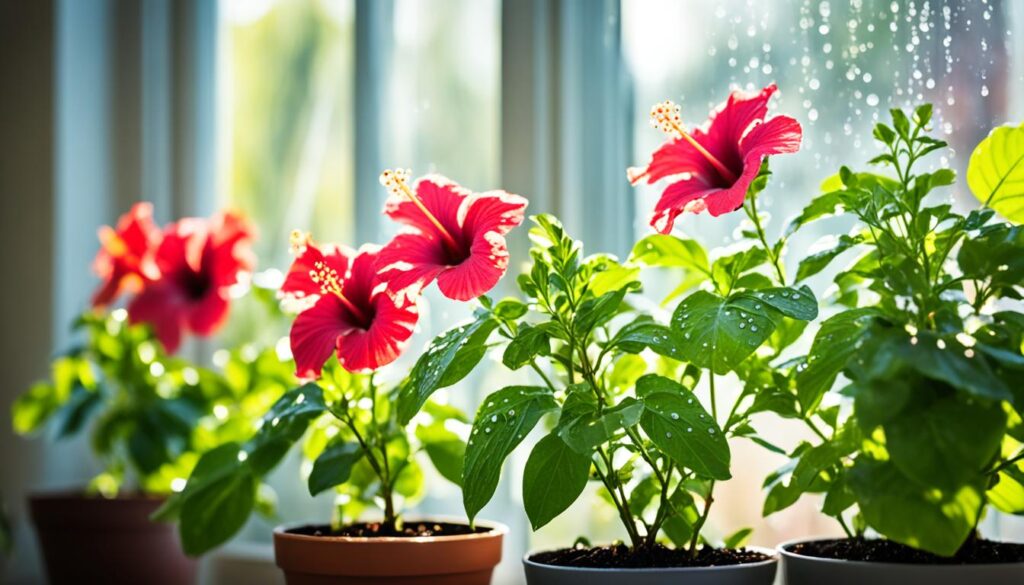
By following these watering and care tips, you can enjoy the beauty of hibiscus plants indoors all year round. Remember to provide adequate sunlight, maintain optimal humidity, and water your indoor hibiscus plants when the soil is dry. With proper care, your indoor hibiscus will thrive, adding a touch of tropical beauty to your Florida home.
Tips for Watering Hibiscus Based on Weather Conditions
To ensure the health and vitality of your hibiscus plants in Florida, it’s crucial to adjust the watering frequency based on the weather conditions. By tailoring your watering practices to the prevailing climate, you can support optimal growth and blooming. Here are some essential tips for watering hibiscus based on weather:
Hotter, Drier, Sunnier, and Windier Conditions:
In periods of intense heat, dryness, abundant sunlight, and strong winds, hibiscus plants may require more frequent watering to prevent dehydration. Consider watering hibiscus up to three times a day to meet their hydration needs during these harsh weather conditions.
Cloudy, Rainy, and Cooler Periods:
During cloudy, rainy, and cooler periods, hibiscus plants experience reduced water evaporation, which means they require less frequent watering. Adjust your watering frequency to once a week or as needed to avoid overwatering during these milder weather conditions.
Remember, the goal is to provide enough water to prevent wilting and maintain healthy growth and blooming. To determine whether it’s time to water, check the moisture level of the soil by sticking your finger a few inches below the surface. If it feels dry, it’s an indication that your hibiscus plants need watering.
| Weather Conditions | Watering Frequency |
|---|---|
| Hotter, Drier, Sunnier, and Windier | Up to three times a day |
| Cloudy, Rainy, and Cooler | Once a week or as needed |
Proper Watering Techniques for Hibiscus in Florida
Proper watering is crucial for the health and vitality of your hibiscus plants in Florida. By following these watering techniques, you can ensure that your hibiscus receives the right amount of moisture and thrives in the sunshine state.
Watering Thoroughly
When watering hibiscus in Florida, it’s important to apply enough water to saturate the soil around the roots. This ensures that the entire root zone receives adequate moisture. Whether you have potted hibiscus or plants in the ground, the key is to water thoroughly.
For potted hibiscus, water slowly and allow the water to penetrate through the entire root ball. This allows the roots to absorb the water effectively and ensures they receive the hydration they need. Avoid overwatering, as this can lead to root rot and other issues.
For hibiscus plants in the ground, create a shallow well around the base of the plant and fill it with water. This helps to ensure that the root zone is properly saturated. The water will seep into the soil, reaching the roots and providing essential moisture.
Using a Drip Watering System
If you want to take your watering technique to the next level, consider using a drip watering system for your hibiscus plants. A drip system delivers water directly to the root zone, ensuring that it is precisely targeted and reduces water waste.
With a drip watering system, you can control the frequency and duration of watering. This allows you to customize the watering schedule based on the specific needs of your hibiscus plants. It’s a convenient and efficient way to ensure your plants receive the right amount of water without any guesswork.
Checking Soil Moisture
Regularly checking the moisture level of the soil is essential for watering hibiscus plants in Florida. Stick your finger a few inches below the surface of the soil to determine its moisture content.
If the soil feels dry, it’s time to water your hibiscus. However, if it feels moist, you can hold off and check again in a day or two. This method helps prevent overwatering and ensures that your hibiscus plants receive water when they need it most.
Remember, overwatering can be just as harmful to hibiscus plants as underwatering. It’s important to find the right balance and provide your plants with adequate moisture without drowning their roots.
Summary
Proper watering techniques are essential for the health and well-being of your hibiscus plants in Florida. Whether you choose to water thoroughly, use a drip watering system, or monitor soil moisture, the goal is to ensure that your hibiscus plants receive the right amount of water at the right time. By following these watering guidelines, you can enjoy vibrant and blooming hibiscus plants in your Florida garden.
| Watering Technique | Benefits |
|---|---|
| Thoroughly watering the root zone | Ensures proper hydration of the roots |
| Using a drip watering system | Precisely delivers water to the root zone, reduces water waste |
| Checking soil moisture | Prevents overwatering and ensures water is provided when needed |
Fertigation for Healthy Hibiscus in Florida
One of the most effective ways to fertilize hibiscus plants in Florida is through a technique called fertigation. Fertigation combines the process of watering and fertilizing, ensuring a steady supply of nutrients to support optimal growth and blooming. By incorporating a high potassium fertilizer into the irrigation system or applying a small amount of fertilizer with every watering, hibiscus plants can receive the essential nutrients they need to thrive.
Fertilizer can be administered in various forms, depending on personal preference and accessibility. Liquid fertilizers can be added to the water used for regular irrigation, providing a consistent nutrient supply to the hibiscus plants. Slow-release fertilizers can also be incorporated into the soil or added to the watering can for less frequent application. Another option is to use high potassium compost that gradually releases nutrients over time.
Fertigation offers numerous benefits for hibiscus plants in Florida. Firstly, it ensures a regular and consistent supply of nutrients, preventing nutrient deficiencies that can hinder growth and flowering. Secondly, the application of fertilizer directly to the root zone reduces the risk of nutrient runoff and waste. Lastly, fertigation allows hibiscus plants to efficiently absorb and utilize the fertilizers, maximizing their effectiveness.
The Benefits of Fertigation for Hibiscus Plants in Florida
Fertigation provides several advantages for hibiscus plants in Florida:
- Consistent nutrient supply: Fertigation delivers a regular and adequate amount of nutrients to hibiscus plants, promoting healthy growth and vibrant blooms.
- Greater nutrient absorption: By applying fertilizers directly to the root zone, hibiscus plants can efficiently absorb and utilize the nutrients, enhancing their overall health and vitality.
- Reduced risk of nutrient loss: Fertigation minimizes the risk of nutrient runoff and waste, ensuring that the fertilizers are utilized by the hibiscus plants rather than being lost to the environment.
- Convenient and time-saving: Fertigation simplifies the process of fertilizing hibiscus plants, as it can be incorporated into regular watering routines, saving time and effort for gardeners.
| Fertilizer Type | Application Method | Frequency |
|---|---|---|
| Liquid fertilizer | Add to irrigation water or watering can | Weekly |
| Slow-release fertilizer | Incorporate into soil or add to watering can | Every 8 weeks |
| High potassium compost | Incorporate into soil | As needed |
It’s important to choose a fertilizer with a high potassium content for hibiscus plants in Florida. Potassium is a crucial nutrient for flower production and overall plant health. Look for fertilizers labeled with a higher potassium (K) number in the NPK ratio on the packaging.
Remember to follow the manufacturer’s instructions when applying fertilizers, as over-fertilization can damage the plants. It’s also essential to monitor the hibiscus plants for any signs of nutrient deficiencies or excesses, such as yellowing or browning leaves, stunted growth, or lack of flowering. Adjust the fertigation schedule or consult with a local horticulturist if any issues arise.
Incorporating fertigation into your hibiscus care routine can help ensure healthy, vibrant, and thriving plants in your Florida garden. By providing a consistent supply of nutrients, hibiscus plants will be better equipped to withstand the challenges of the Florida climate and showcase their beautiful blooms.
Tips for Caring for Hibiscus in Florida
In addition to proper watering, caring for hibiscus plants in Florida is essential to ensure their health and beauty. Here are some tips to help you maintain vibrant and thriving hibiscus plants:
1. Planting in the Right Conditions
Ensure that your hibiscus plants are planted in areas with full sunlight and well-drained soil. Hibiscus thrives in direct sunlight, so choose a location that receives at least six hours of sunlight each day. The soil should be rich and well-drained to prevent waterlogging, which can lead to root rot.
2. Regular Pruning
Pruning is essential to maintain the shape and overall health of your hibiscus plants. Remove any dead, damaged, or diseased branches to promote new growth and prevent the spread of diseases. Prune your hibiscus plants in late winter or early spring before new growth begins.
3. Fertilize Regularly
Hibiscus plants benefit from regular fertilization to provide them with the necessary nutrients for healthy growth and abundant blooming. Use a high potassium fertilizer, specifically formulated for hibiscus plants, and follow the instructions on the packaging for application rates and frequency. Fertilize your hibiscus plants during the growing season to support their growth and blooming potential.
4. Monitor for Pests and Diseases
Hibiscus plants can be susceptible to various pests and diseases, including aphids, spider mites, and fungal infections. Regularly inspect your plants for any signs of infestation or disease. If you notice any issues, take appropriate measures to address them promptly. This may include using organic pest control methods or consulting with a professional if necessary.
5. Indoor Care Tips
If you have indoor hibiscus plants in Florida, there are a few additional care tips to keep in mind. Maintain humidity levels by placing a tray of water near the plants or using a humidifier. Ensure that the plants receive adequate sunlight by placing them near a south-facing window or using grow lights. Regularly dust the leaves to keep them clean and free from pests.
6. Image of Caring for Hibiscus in Florida
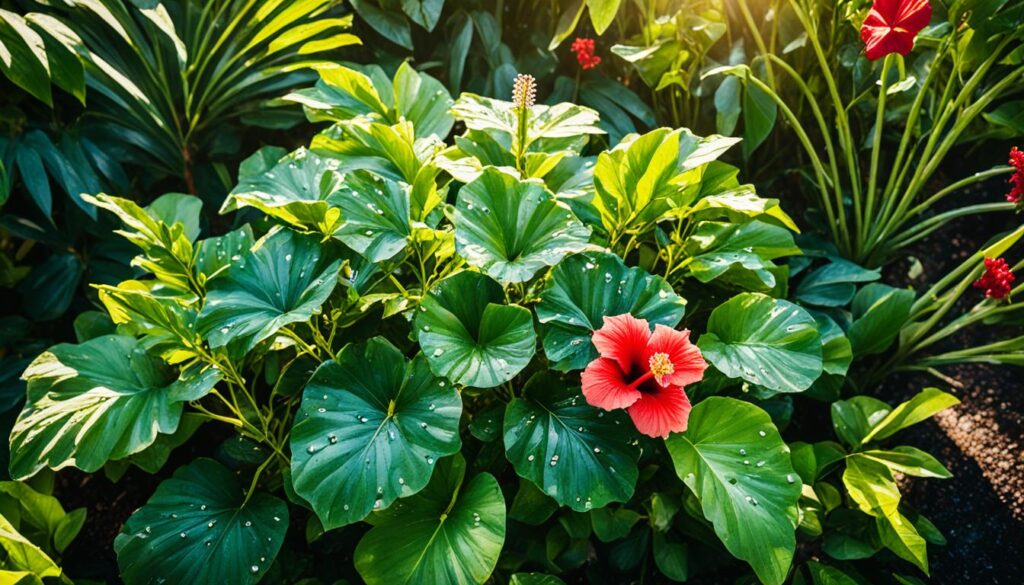
By following these care tips, you can enjoy beautiful hibiscus plants in your Florida garden. Remember to water your hibiscus plants according to the recommended schedule and adjust based on weather conditions. With proper care, your hibiscus plants will reward you with stunning blooms and lush foliage year after year.
Conclusion
Proper watering is crucial for maintaining healthy and vibrant hibiscus plants in Florida. By paying attention to soil moisture, weather conditions, and employing the right techniques, Florida gardeners can ensure their hibiscus thrives. Established hibiscus should be watered twice a week during their first year, gradually reducing it to once a week. Container-grown hibiscus and indoor plants require consistent watering to maintain optimal moisture levels. Incorporating a high potassium fertilizer through fertigation can provide essential nutrients for robust growth and blooming.
Aside from watering, it’s also essential to follow other care tips to keep hibiscus plants in their prime. Choose suitable planting locations with full sunlight and well-drained soil. Regular pruning helps maintain an attractive shape and remove any dead or diseased branches. Monitoring for pests and diseases is crucial to catch and address issues early on. Florida gardeners can enjoy healthy and vibrant hibiscus plants by following these care tips and providing the appropriate environment for growth.
With this comprehensive hibiscus watering guide for Florida and the accompanying care tips, gardeners can confidently nurture their hibiscus plants. Remember to adjust watering schedules based on weather conditions and use proper watering techniques. By caring for hibiscus diligently, Florida gardeners can enjoy the beauty and tropical allure of these stunning flowers.



